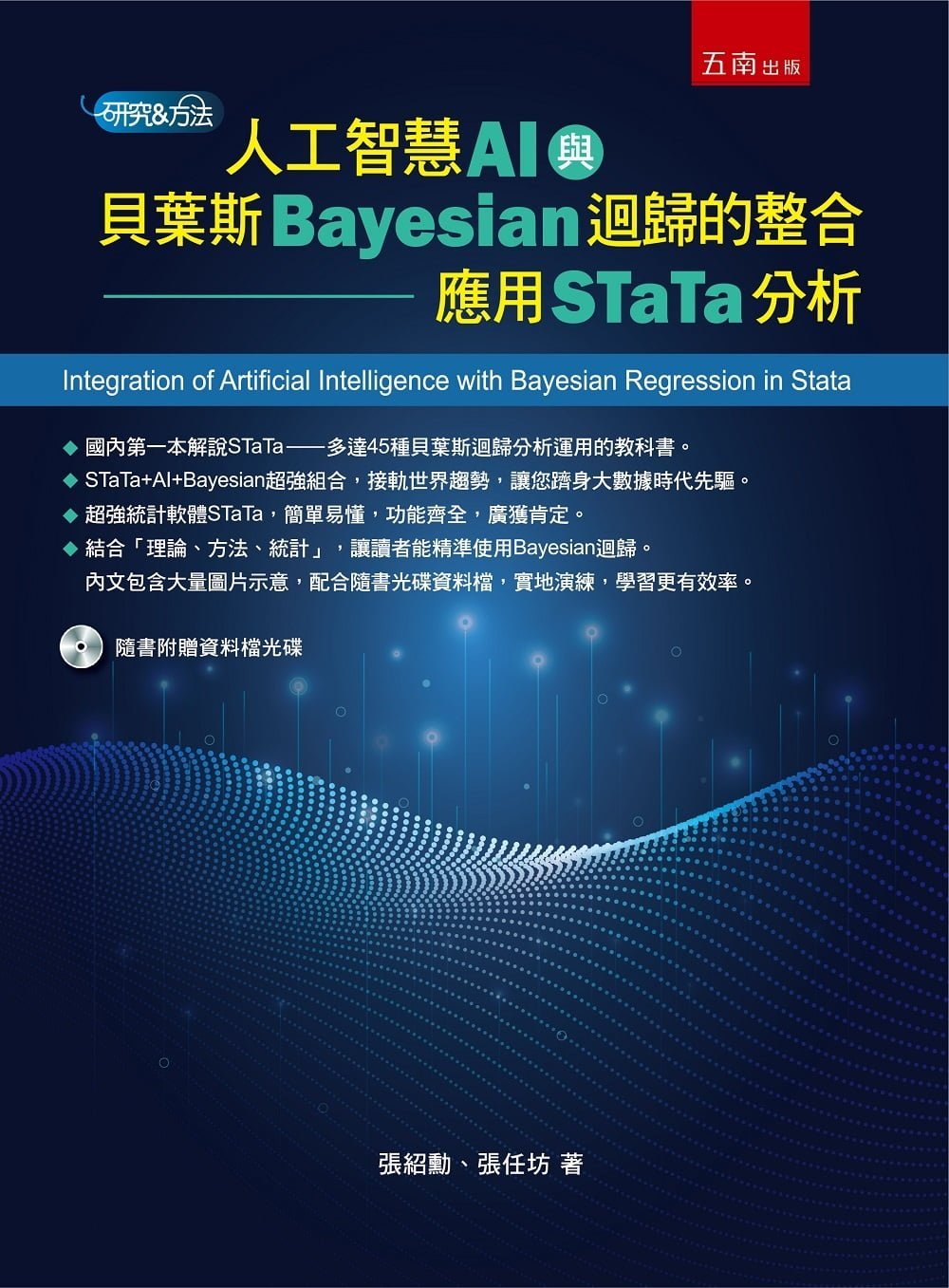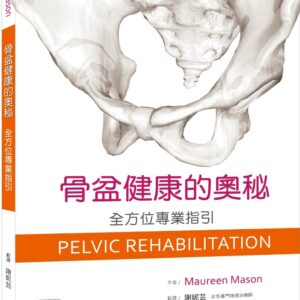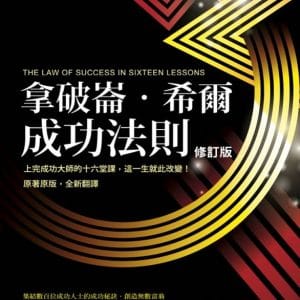Description
人工智慧(AI)與貝葉斯(Bayesian)迴歸的整合:應用STaTa分析
●國內第一本解說STaTa ——多達45 種貝葉斯迴歸分析運用的教科書。
●STaTa AI Bayesian超強組合,接軌世界趨勢,讓您躋身大數據時代先驅。
●超強統計軟體STaTa,簡單易懂,功能齊全,廣獲肯定。
●結合「理論、方法、統計」,讓讀者能精準使用Bayesian迴歸。
●內文包含大量圖片示意,配合隨書光碟資料檔,實地演練,學習更有效率。
5G時代的來臨,聯手(AI)人工智慧邁入嶄新紀元,未來可預見日常將出現更密集的AI科技,更可能改變產業型態、生活體驗,甚至是人類的思考模式。
AI又稱機器智能,迄今已是一門顯學,屬於自然科學和社會科學的交集。其中機器學習演算法及Bayesian後驗機率等貝氏推論,不僅適合傳統科學研究法,更適合於當今大數據(big data)時代的來臨。
本書詳細說明STaTa運用中,45種Bayesian迴歸,以及實務上已非常成熟的AI統計應用技術,可供人工智慧、機器學習等自然科學和社會科研究者使用。內文包含大量圖片示意,搭配隨書附贈光碟,簡潔易懂,學習效果更顯著。
自 序
Chapter 01 人工智慧的基礎:機器學習理論及貝氏定理(Bayes' theorem) 1
1-1 人工智慧(Artificial Intelligence, AI) ……………………………………………………………….9
1-1-1 AI 研究的議題 …………………………………………………………………………………10
1-1-2 強人工智慧vs. 弱人工智慧 ……………………………………………………………..14
1-1-3 AI 研究方法 …………………………………………………………………………………….15
1-2 機器學習(machine learning) ………………………………………………………………………..19
1-2-1 監督vs. 非監督機器學習 …………………………………………………………………24
1-2-2 機器學習的演算法(algorithm) ………………………………………………………….26
1-2-3 何謂Features( ≈自變數)、Training、Label( ≈類別依變數)? ……………40
1-2-4 監督機器學習⊃多變數線性迴歸(machine learning: linear regression with
multiple variables) …………………………………………………………………………….42
1-2-5 機器學習:梯度下降演算法(gradient descent algorithm) ……………………67
1-2-6 機器學習:特徵縮放(feature scaling) ……………………………………………….81
1-3 參數估計:最大概似估計、最大後驗(Max posterior)、貝葉斯估計 …………….81
1-3-1 何謂參數估計? ………………………………………………………………………………83
1-3-2a 估計法一:最大概似估計(MLE) ≠概似比(LR) ………………………………87
1-3-2b 最大概似估計法(MLE) 做分類 ………………………………………………………..97
1-3-3 估計法二:最大後驗(Max posterior) 估計 …………………………………….. 101
1-3-4 估計法三:貝葉斯估計 ………………………………………………………………… 105
1-4 期望最大化(EM) 演算法 …………………………………………………………………………. 107
Chapter 02 貝葉斯(Bayesian) 迴歸有45 種 117
2-1 貝氏定理與條件機率( 重點整理) ……………………………………………………………. 118
2-1-1 貝氏機率(Bayesian probability) …………………………………………………….. 121
2-1-2 貝氏(Bayes) 定理、條件機率……………………………………………………….. 123
2-2 貝葉斯推論(Bayesian inference) ………………………………………………………………. 136
2-2-1 貝葉斯法則(Bayesian rule) …………………………………………………………… 138
2-2-2 推論「排他性和窮舉命題」的可能性(inference over exclusive and
exhaustive possibilities) …………………………………………………………………. 143
2-2-3a 貝葉斯推論之數學性質(mathematical properties) …………………………… 145
2-2-3b 貝葉斯決策理論 …………………………………………………………………………… 153
2-2-4 貝葉斯推論之案例 ……………………………………………………………………….. 160
2-2-5 頻率統計和決策理論之貝葉斯模型,誰優?Bayesian Information
Criterion (BIC) ……………………………………………………………………………… 165
2-2-6 貝葉斯認識論(Bayesian epistemology) ………………………………………….. 167
2-2-7 貝葉斯推理的影響因素 ………………………………………………………………… 170
2-3 常見的分布有15 種 …………………………………………………………………………………. 175
2-4 STaTa likelihood-based Bayesian 迴歸有45 種 …………………………………………… 204
2-4-1 STaTa 共12 類:45 種Bayesian 迴歸 ……………………………………………. 205
2-4-2 Metropolis-Hastings 演算法(bayesmh 指令) 和Monte Carlo …………… 215
2-4-3 貝葉斯線性迴歸的基本原理 …………………………………………………………. 225
2-5 貝葉斯統計及正規化(Bayesian statistics and Regularization) ……………………… 228
2-5-1 過度適配vs. 不足適配(overfitting and underfitting) ……………………….. 229
2-5-2 Bayesian statistics 及正規化(regularization) ……………………………………. 231
2-5-3 最佳成本函數之正規化(optimize cost function by regularization) ……. 232
Chapter 03 最大概似(ML) 各家族(family):機器學習技術 237
3-1 最大概似(ML) 之Regression 家族(family) ………………………………………………. 238
3-1-1 迴歸分析介紹 ………………………………………………………………………………. 239
3-1-2 線性迴歸(linear regression) …………………………………………………………… 241
3-2 多元迴歸的自變數選擇法有三:子集合選取法、正規化、資訊準則法
(bayesstats ic 指令) ………………………………………………………………………………….. 246
3-2-1 迴歸模型與正規項(regulation):Ridge 迴歸、Lasso 迴歸原理 ………. 253
3-2-2 脊迴歸/嶺迴歸(ridge) 的原理:多重共線性(ridgeregress 外掛指令)
……………………………………………………………………………………………………. 262
3-2-3a 迴歸正規項(regulation):lasso 迴歸、Ridg 迴歸、elastic-net 迴歸
(lassoregress、ridgeregress、elasticregress 外掛指令) …………………….. 266
3-2-3b 機器學習演算法:套索迴歸(Lasso Regrission)(lassoregress、lasso2、
elasticregress 指令) ………………………………………………………………………. 283
3-2-4a 機器學習演算法:脊迴歸(Ridge Regression)(rxridge、rxrcrlq、rxrmaxl
等14 個指令) ………………………………………………………………………………. 288
3-2-4b Ridge 迴歸分析:解決共線性(rxridg 外掛指令) …………………………… 293
3-2-5 機器學習演算法:彈性網路多工Lasso 迴歸(multi task Lasso)
(elasticregress 指令) ……………………………………………………………………… 299
3-2-6 邏輯斯迴歸(logistic regression) …………………………………………………….. 301
3-3 機器學習法:隨機森林( 外掛指令randomforest)、支援向量機( 外掛指令
svmachines) ……………………………………………………………………………………………… 314
3-3-1 機器學習法:隨機森林( 外掛指令:randomforest) ……………………….. 314
3-3-2 機器學習法:支援向量機SVM( 外掛指令:svmachines) ………………. 326
3-4 最大概似的Kernel-Based 家族:小樣本、非線性及高維模型識別 ……………. 349
3-4-1 非線性分類之核函數 ……………………………………………………………………. 353
3-4-2 支援向量機(SVM) 分類器:原型、對偶型、核技巧、現代方法 …… 354
3-4-3a 支援向量機(SVM) 原理:小樣本、非線性及高維模型識別 ………….. 361
3-4-3b 支援向量機做分類(svmachines 外掛指令) ……………………………………. 368
3-4-4 核迴歸/分段加權迴歸(kernel regression):非單調函數(lpoly、
npregress、teffects 指令) ………………………………………………………………. 377
3-5 最大概似(ML) 之Bayes-Based 家族( 前導字「bayes: 某迴歸」指令) ……… 399
3-5-1 判別模型(discriminative model) 與生成模型(generative model) ……… 404
3-5-2 高斯判別分析(Gaussian discriminant analysis) ……………………………….. 407
3-5-3 樸素貝葉斯(naive bayes) 演算法…………………………………………………… 412
Chapter 04 貝葉斯(Bayesian) 線性迴歸之原理 421
4-1 貝葉斯(Bayesian) 分析 ……………………………………………………………………………. 425
4-2 參數估計:最大概似估計、最大後驗估計、貝葉斯估計 ………………………….. 430
4-3 貝葉斯(Bayesian) 線性迴歸 …………………………………………………………………….. 433
4-3-1a 線性迴歸之參數估計最小平方法 (OLS) ………………………………………… 433
4-3-1b 貝葉斯(Bayesian) 迴歸之原理 ………………………………………………………. 436
4-3-2 貝葉斯線性迴歸:參數分布、預測分布、等價核 …………………………. 440
4-3-3 貝葉斯線性迴歸:學習過程、優缺點、貝葉斯脊迴歸 ………………….. 447
4-4 貝葉斯多元線性迴歸之原理(Bayesian multivariate linear regression) …………. 451
Chapter 05 Bayes 線性迴歸(「bayes: regress」、「bayesgraphdiagnostics」、「bayesstats ic」指令) 457
5-1 線性Bayesian 迴歸( 先rsquare、再「bayes: regression」指令) ………………… 459
5-1-1 OLS 先挑所有自變數的最佳組合( 再Bayes 線性迴歸) ………………… 460
5-1-2 OLS 先挑所有自變數的最佳組合,再Bayes 線性迴歸
(bayes : regress y x1 x2 x3) …………………………………………………………….. 477
5-2 方法一Bayes 線性迴歸(bayes : regress ⋯指令) ……………………………………….. 483
5-2-1 Bayes 線性迴歸及預測值:使用內定概似及先驗(uninformative data)
(bayes : regress ⋯指令) ………………………………………………………………… 483
5-2-2 Bayes 線性迴歸:自定概似及先驗(informative data)(bayes : regress
⋯指令) ……………………………………………………………………………………….. 491
5-3 方法二Bayes 線性迴歸(bayesmh : regress ⋯指令) ………………………………….. 501
5-4 線性Bayesian 迴歸模型( 改用bayesmh 指令) …………………………………………. 512
5-4-1 Bayesian 估計之原理及實作(「bayes: regress」指令) ……………………. 516
5-4-2 MCMC 收斂性(convergence) 及假設檢定(hypotheses testing) ………… 525
5-4-3 先驗(Priors):Gibbs 採樣(sampling) …………………………………………….. 529
5-4-4 自定先驗(Custom priors)………………………………………………………………. 533
5-5 Bayes 迴歸:縮減模型vs. 完全模型,誰優?(bayesmh、bayesstats ic 指令) … 535
Chapter 06 Metropolis-Hastings 演算法之Bayesian模型(bayesmh 指令) 545
6-1 bayesmh 指令:「線性vs. 非線性」、「單變量vs. 多變量」、「連續vs. 間斷」
模型有8 大類 ………………………………………………………………………………………….. 552
6-2 bayesmh 指令之範例 ……………………………………………………………………………….. 573
6-2-1 範例1:OLS 線性迴歸(regress)vs. Bayesian 線性迴歸(bayes : regress)
……………………………………………………………………………………………………. 574
6-2-2 範例2:Bayesian normal linear regression with noninformative prior
( 未自定參數的分布) …………………………………………………………………… 583
6-2-3 範例3:Bayesian linear regression with informative prior( 自定參數
的分布) ……………………………………………………………………………………….. 588
6-2-4 範例4:Bayesian normal linear regression with multivariate prior …….. 591
6-2-5 範例5:檢查收斂性(Checking convergence) …………………………………. 594
6-2-6 範例6:貝氏事後估計值摘要(Postestimation summaries) ……………… 599
6-2-7 範例7:敵對模型的比較(Model comparison) ……………………………….. 601
6-2-8 範例8:假設檢定(Hypothesis testing)( bayestest model、interval
interval) ……………………………………………………………………………………….. 603
Chapter 07 Bayesian 邏輯斯模型、多項邏輯斯模型(bayes: logistic、bayes: mlogit 指令) 607
7-1 邏輯斯迴歸原理 ………………………………………………………………………………………. 608
7-2 Bayesian logit 迴歸分析(bayes: logit、bayes : logistic 指令) ……………………… 612
7-2-1 範例1:貝氏Logistic 迴歸(bayes: logit 指令) ………………………………. 614
7-2-2 範例2:自定之資訊先驗(informative prior):貝氏Logistic 迴歸
(bayes: logit 指令) ………………………………………………………………………… 618
7-3 對照組:multinomial logistic 迴歸分析(bayes: mlogit 指令) ……………………… 621
7-3-1 多項(multinomial) 邏輯斯迴歸之原理 …………………………………………… 622
7-3-2 Multinomial Logit 迴歸分析:職業選擇種類(mlogit 指令) ……………. 628
7-3-3 多項邏輯斯迴歸分析:乳房攝影(mammograph) 選擇的因素
(mlogit 指令) ……………………………………………………………………………….. 637
7-4 實驗組:Bayesian multinomial logistic 迴歸分析:健康保險(bayes: mlogit
指令) ……………………………………………………………………………………………………… 650
Chapter 08 聯立方程式:Bayesian multivariate 迴歸(bayes: mvreg 指令) 659
8-1 多變量Bayesian 迴歸分析(bayes: mvreg 指令) ………………………………………… 660
Chapter 09 非線性迴歸:廣義線性模型(GLM)(Baye: glm 指令) 667
9-1 廣義線性模型之原理 ……………………………………………………………………………….. 668
9-2 當依變數是比例(proportion) 時,如何做迴歸(glm 指令)? …………………….. 671
9-3 廣義線性迴歸(glm、baye: glm 指令) ………………………………………………………. 684
Chapter 10 Survival 模型(baye: streg 指令) 693
10-1 存活分析的原理 ………………………………………………………………………………………. 694
10-1-1 存活分析之定義 …………………………………………………………………………… 695
10-1-2 為何存活分析是臨床研究最重要的統計法? ………………………………… 698
10-1-3 存活分析之三種研究目標 …………………………………………………………….. 703
10-2 存活分析Bayesian 迴歸 (baye: streg 指令) ……………………………………………….. 704
Chapter 11 多層次(multilevel) 模型(bayes: mixed 指令)717
11-1 多層次模型的原理 …………………………………………………………………………………… 720
11-2 Bayesian 多層次模型:重複測量(bayes: mixed 指令) ………………………………. 726
Chapter 12 計數(count) 模型、Zero-Inflated 模型(bayes: tpoisson、baye: zinb 指令) 743
12-1 傳統原理:Count 依變數:Zero-Inflated Poisson 迴歸 vs. negative binomial
迴歸 ………………………………………………………………………………………………………… 744
12-1-1 Poisson 分配 ………………………………………………………………………………… 745
12-1-2 負二項分配(Negative Binomial Distribution) ………………………………….. 751
12-1-3 零膨脹(Zero-Inflated)Poisson 分配 ………………………………………………… 753
12-2 單層次:Zero-Inflated Poisson 迴歸vs. 負二項迴歸(zip、zinb 指令) ………… 755
12-2-1 傳統:Zero-Inflated Poisson 迴歸vs. 負二項迴歸(zip、zinb 指令) … 755
12-2-2 Bayesian Poisson 迴歸(bayes: poisson)、Bayesian 零膨脹Poisson
迴歸(bayes: zip 指令) ………………………………………………………………….. 776
12-2-3 Zero-Inflated negative binomial 模型(bayes: zinb 指令) ………………….. 792
12-3 Zero-Inflated ordered probit regression 練習:釣魚(zip 指令) …………………….. 804
12-4 零膨脹Ordered probit 迴歸分析:抽菸嚴重度(zioprobit 指令) …………………. 805
12-5 截斷(truncated) Poisson 迴歸分析(bayes: tpoisson 指令) ………………………….. 813
12-5-1 截斷迴歸(truncated regression)(truncreg 指令) ………………………………. 813
12-5-2 Bayesian 截斷Poisson 迴歸(truncated regression)(bayes: tpoisson 指令)
……………………………………………………………………………………………………. 832
Chapter 13 Bayesian 自我迴歸模型 (bayes : regress yL1.y 指令) 841
13-1 時間列序之統計:自我迴歸(autoregressive models) …………………………………. 842
13-1-2 ARIMA 建構模型之步驟 ………………………………………………………………. 844
13-2 穩定數列之自我迴歸模型(AR) ……………………………………………………………….. 846
13-2-1 AR(1) 模型 …………………………………………………………………………………… 848
13-2-2 AR(2) 模型 …………………………………………………………………………………… 854
13-2-3 何謂穩定性( 定態)? ………………………………………………………………….. 858
13-3 Bayesian 自我迴歸之建模過程(bayes : regress y L.y 指令) ……………………….. 859
參考文獻 875
书名简译: 人工智能(AI)与贝叶斯(Bayesian)回归的整合:应用STaTa分析


























There are no reviews yet.